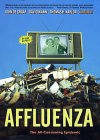Summary | Excerpt | Reviews | Readalikes | Genres & Themes | Author Bio

The All-Consuming Epidemic
by Wann, de Graaf, Naylor
Jason is, admittedly, an imaginary, composite kid. But his experience at the mall is far from atypical. In 1999, according to the National Retail Foundation, Americans spent nearly $200 billion on holiday gifts, more than $850 per consumer. Affluenza season, the month between Thanksgiving and Christmas, generated twenty-five percent of all retail profits
Most Americans tell pollsters they want less emphasis on holiday spending and gift-giving. A third cannot even remember what they gave their significant other the previous year, and many cannot pay off their Christmas debts until the following summer, if then. Yet the urge to splurge continues to surge. It's as if we Americans, despite our intentions, suffer from some kind of Willpower Deficiency Syndrome, a breakdown in affluenza immunity.
MALL MANIA Since World War II, Americans have been engaged in a spending binge unprecedented in history and fueled to a frenzy by the booming economy of the past several years. We now spend nearly $6 trillion a year, more than $21,000 per person, most of it on consumer goods, which account for two-thirds of the recent growth in the U.S. economy. For example, we spend more on shoes, jewelry, and watches ($80 billion) than on higher education ($65 billion). On a five-day shopping trip to Paris, the wife of Florida governor Jeb Bush spent $19,000, though she reported only $500 of it to U.S. Customs. But she's not alone in her passion for shopping.
In 1986, America still had more high schools than shopping centers. Less than fifteen years later, we have more than twice as many shopping centers as high schools. In the Age of Affluenza (as we believe the decades surrounding the Second Millennium will eventually be called), shopping centers have supplanted churches as a symbol of cultural values. In fact, seventy percent of us visit malls each week, more than attend houses of worship.
Our equivalent of Gothic cathedrals are the megamalls, which continually replace smaller shopping centers, drawing customers from ever-greater distances. Typically, they cover areas of fertile farmland that formerly produced bumper crops instead of traffic jams. Indeed, forty-six acres of prime American farmland are lost to "development" every hour. When a new megamall opens, the pomp and ceremony rival anything Notre Dame or Chartres might have witnessed in medieval times.
The Super Mall in Auburn, Washington, opened to a stampede of 100,000 shoppers in October 1995. The crowd gathered under an imitation of Washington's 14,410-foot Mt. Rainier. Rising above the Super Mall's front entrance, the imitation mountain provided one show which the real thing could not: a display of fireworks, set off as soon as the ribbon-cutting ceremony was over.
In a spirit of boosterism that would have impressed Sinclair Lewis' Babbitt, speaker after speaker extolled the wonders of the new shopping center, the biggest in the state. "The number of shoppers expected to visit here over the next year exceeds 1.2 million," bubbled Auburn's mayor, adding that "committed shoppers can shop till they drop in 1.2 million square feet of shopping space." Along with a new race track and casino in the area, the mall was expected to become a "destination attraction" for vacationers from the entire western United States and Canada. It would, they said, create 4,000 jobs and "improve the quality of life throughout the region." Thirty percent of the expected business would come from tourists who would each spend about five hours and more than $200 at the mall.
FUN FOR THE WHOLE FAMILY The thousands of eager shoppers on hand for the opening wore bored and impatient expressions during the speeches, but pushed eagerly through the open doors when the rhetoric stopped. One woman said she was "really excited about the mall because this is something we haven't had in this part of Washington. We were waiting for something like this."
From Affluenza: The All-Consuming Epidemic, by John De Graaf, et al. © June 9, 2001, Berrett-Koehler used by permission.




If there is anything more dangerous to the life of the mind than having no independent commitment to ideas...
Click Here to find out who said this, as well as discovering other famous literary quotes!
Your guide toexceptional books
BookBrowse seeks out and recommends the best in contemporary fiction and nonfiction—books that not only engage and entertain but also deepen our understanding of ourselves and the world around us.